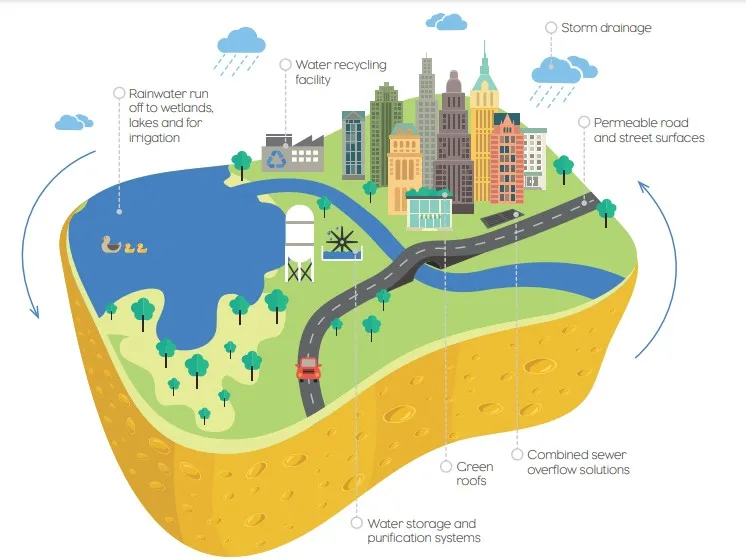Syllabus: GS3/Disaster Management; Urban Infrastructure
Context
- Heavy rainfall in northern India has caused widespread flooding, landslides, that damage basic infrastructures and food supplies can be tackled using the innovative concept of sponge cities.
Urban Flooding in India
- Urban flooding occurs when built-up areas — such as cities and towns — experience inundation due to heavy rainfall, rapid snowmelt, or other sources of water runoff.
- Unlike rural floods, which typically affect flat or low-lying regions, urban flooding is a man-made disaster exacerbated by factors like unplanned urbanisation and inadequate drainage systems.
- As our cities grow, they alter natural processes, replacing permeable land surfaces with concrete and asphalt, which limits the ground’s ability to absorb rainwater.
- Consequently, surface runoff overwhelms drainage systems, leading to disruptions, property damage, and even loss of life.
Causes of Urban Flooding in India
- Unplanned Urbanisation: Rapid urban growth often occurs in low-lying areas due to rising land prices and limited availability in city centres.
- Unfortunately, these developments often encroach upon lakes, wetlands, and riverbeds, reducing the capacity of natural drains and exacerbating flooding.
- Impervious Surfaces: Roads, buildings, and other impervious structures prevent rainwater from seeping into the ground.
- As cities expand, the natural ability of soil to absorb water diminishes, leading to increased surface runoff.
- Ground Subsidence: The weight of heavy buildings and excessive groundwater extraction can cause ground subsidence, making urban areas more susceptible to flooding.
Sponge Cities: A Nature-Based Solution
- The concept of ‘sponge cities’ originated in China and has gained attention worldwide. These cities prioritise flood management by emphasising green infrastructure over traditional grey infrastructure (pipes and pumps).
- Green Infrastructure: Instead of relying solely on concrete drainage systems, sponge cities incorporate natural elements like plants, trees, wetlands, and permeable pavements. These act as ‘sponges’ by absorbing rainwater, slowing down its flow, and purifying it.
Working
- Permeability: Sponge cities prioritise permeable surfaces. Instead of vast concrete jungles, they incorporate green spaces, parks, and porous pavements. These surfaces allow rainwater to infiltrate the ground, replenishing aquifers and reducing surface runoff.
- Storage and Retention: These cities store rainwater strategically. They create retention ponds, wetlands, and underground storage tanks to capture excess water during heavy rainfall. By doing so, they prevent sudden floods downstream.
- Natural Drainage: Sponge cities restore natural drainage systems. They revive rivers, streams, and wetlands, allowing water to flow naturally. This approach mimics nature’s hydrological cycle, preventing urban floods.

Benefits
- Flood Reduction: By retaining and gradually releasing rainwater, sponge cities prevent flash floods.
- Ecological Biodiversity: Urban parks, green spaces, and wetlands improve biodiversity and provide habitats for wildlife.
- Heat Island Mitigation: Vegetation helps cool urban areas, reducing the heat island effect.
- Water Scarcity Alleviation: Capturing rainwater contributes to water availability during dry spells.
| Case Study: Guwahati’s Flooding Challenges – Infrastructure Mess: Citizens face anxiety due to inadequate infrastructure. The Guwahati Metropolitan Development Authority (GMDA) often operates without engaging with the public or understanding their needs. The municipal corporation, responsible for urban planning, is sidelined, leaving a governance gap. – Haphazard Urban Development: Brokers have played a role in sub-letting land and plots, resulting in haphazard development. Open spaces have been encroached upon, exacerbating the problem. – Incomplete Drainage System: The drainage system remains inadequate due to poor planning and incomplete execution of past development plans. Steps Toward Resilience – Town Planning Schemes: Recent adoption of town planning schemes in Guwahati signals progress. However, more needs to be done to fix fundamental flaws. – Revisit Drainage Plans: Focusing on major drainage channels and revisiting the 1972 drainage plan could improve water flow. Implementing this effectively is crucial. Examples of Sponge Cities – China has been at the forefront of implementing sponge city principles. China launched the Sponge City Initiative in 2015, investing in projects that can absorb floodwater. They are building these projects in 30 cities, including Shanghai, Wuhan, and Xiamen. – Wuhan: This city transformed its urban landscape by creating permeable pavements, green roofs, and wetlands to manage stormwater. – Chengdu: By integrating natural features like lakes and green spaces, Chengdu reduced flood risk and improved water quality. – Xiamen: Xiamen’s sponge city initiatives include rain gardens, retention ponds, and porous pavements. Learning from Other Cities – Chennai: The Greater Chennai Corporation aims to transform the entire city into a sponge. Fifty-seven ponds are being developed as model Sponge City Parks, emphasising both flood control and groundwater recharge. – Bengaluru: Bengaluru is exploring sponge city systems, including underground storage tanks, to combat flash floods. |
Conclusion
- As India faces the dual challenges of rapid urbanisation and climate change, adopting sponge city principles could be transformative.
- By blending nature with urban design, sponge cities can create resilient, sustainable cities that effectively manage water, reduce flooding, and enhance overall livability.
Next article
News In Short-27-09-2024